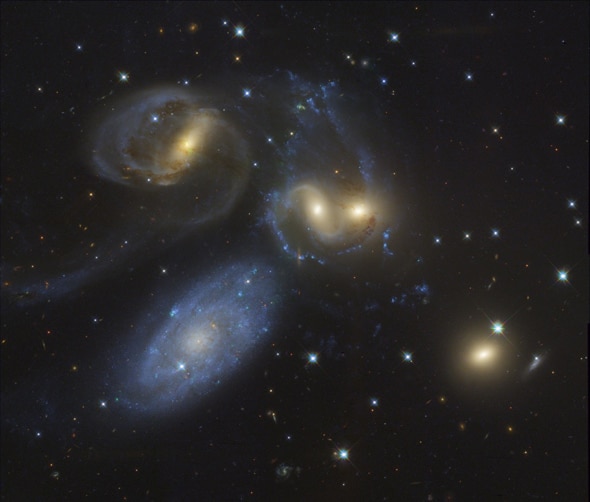Create a free profile to get unlimited access to exclusive videos, sweepstakes, and more!
Stephan’s Quintet Has a Shocking Surprise

For the past year I’ve been working on creating Crash Course Astronomy. The majority of the work comes in writing it, of course; 2,200 words per script once a week is a bit of writing.
Part of the work I do is also finding images and videos to use for the series. Thought Café does our great cartoon animations, but we also need to show the glory of the heavens using telescopes, computer animations, and the like. So every week I scour the archives of NASA, ESA, and more, looking for appropriate imagery.
I learn a lot writing the show, but I sometimes learn something finding these graphics, too.
The image above shows a famous compact group of galaxies called Stephan’s Quintet. Located roughly 300 million light-years away, it’s not really a quintet: The galaxy at the bottom left is actually much closer to us (about 40 million light-years away), and only coincidentally aligned with the more distant group.
It’s almost obvious in hindsight. The four group members are yellowish and have interacted with each other; their mutual gravity has distorted their shapes and drawn out long tidal tails. The other galaxy is blue, and looks undisturbed.
I’ve known all this for some time. But I found another image of them while searching for galaxy cluster images for an upcoming episode of Crash Course, and it’s pretty cool. It’s a composite of far-infrared Spitzer Space Telescope images and optical light images taken using the Calar Alto Observatory in Spain.
In the image, warm hydrogen (which normally appears red to the eye) is displayed as green. See that huge green arc? That’s a vast shock wave, created as one of the galaxies rams through the intergalactic gas at high speed and violently compresses it. The gas is heated and glows, and its size is phenomenal: It’s more than 100,000 light-years across, bigger than our own galaxy! It’s one of the biggest shock waves ever seen.
I was unaware of this shock wave before I found this image, so, like I said, I learned something. Funny, too, my first thought was that gas shocked like this should be visible in X-rays as well, since it should be heated to a million degrees or more from the incredible energies of the galactic collision. Sure enough, that’s the case. And if you compare that image with the one from Hubble, you'll see that arc corresponds to a blue arm of the galaxy; that's from newly born luminous and massive blue stars. These form in galactic collisions sometimes when gas is compressed and give birth to large numbers of stars. It all hangs together.
Not only that, but I also found out there’s another galaxy nearby in the sky at the same distance as the other four, meaning this may actually be a quintet after all!
That’s pretty cool. I’ve read a few papers on the Quintet, and have looked at countless photos of them, so I’m delighted to find something new about them.
And you know what? I can’t help but think that, somehow, the galaxies themselves are happy about it too.


























